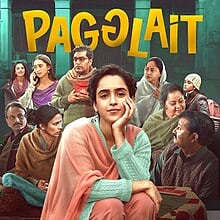With its skillful cast and brilliant script, Pagglait is a 2021 dark comedy-drama that was released on Netflix on 26 March 2021. It’s a must-watch for everyone interested in deconstructing the hypocrisy and blatant misogyny of Indian households within a patriarchal setting.
Written by Umesh Bist, Pagglait is a narrative about Sandhya, an Indian woman caught in the ugly shackles of a meaningless marriage. With the passing away of her husband, she gradually becomes the woman she needs to be. The thirteen-day ritual of her husband’s passing, brings her to self-growth and self-worth, thus giving her a rebirth. Thus, devoid of a very dramatic or scintillating plot, the Netflix drama revolves around Sandhya who has to die in order to be reborn, like a phoenix rising from the ashes.
While Sandhya struggles to rediscover her newly gained identity, one can see a number of plotlines weaving a narrative that points towards the oddity surrounding the institution of marriage and the convenient ignorance of a woman’s wants. Such ironies can only exist in an Indian context where death brings more enlightenment than life, itself.
Set in the grimy streets and ancestral abode of Shanti Kunj, the plot opens with men and women grieving in their own little ways, while they also struggle to meet ends. What follows is a series of complex rituals so as to perform the last rites in a rightful manner. It’s not much later that the audience is also introduced to the “log kya kahenge” ritual with quirky comments including a relative saying how Sandhya “is not inauspicious as their horoscopes were compatible” when someone tries to question Astik’s passing.
We are introduced to a rather bored Sandhya in the following scenes who casually yawns while reading the condolences, and later demands coke instead of chai so much so as to let everyone believe that she is not really grieving the death of her husband. The audience remains rather perplexed if she is in denial or was her marriage too hollow to even allow her to grieve. The rest of the storyline, then, becomes a quest of answering such questions so that Sandhya can gradually embrace her unresolved feelings and move forward as an individual.
Acts such as the disgust of Sandhya on seeing the white sari that her mother brought for her or the frustration of her brother-in-law having to shave off his head further allow us to deconstruct and reassess the depth and effectiveness of such rituals, and if they really stand for anything at all, especially in the face of individual identity and pursuit in the 21st century. Other concerns such as the disgust of Sandhya’s in-laws at one “Nazia Zaidi” and the religious discrimination still prevalent at large hover in the background which all come to the forefront in this patriarchal framework of an Indian setting.
The fact that her mother regards Sandhya topping her batch in MA English as the “qualification” required to get a nice groom with a 70,000 salary further makes one contemplate how deep the roots of such blatant misogyny and orthodox upbringing really go.
The discovery of Astik’s pre-marital affair, then, only becomes a catalyst in allowing Sandhya to break through this rotten carcass of a marriage, thus giving her closure. She gradually moves forward on the path of knowing what love is and understanding that she can only love someone else when she falls in love with herself.
Such discoveries are underlined and garbed in the layer of humor and mocking of Indian funerals, in general. In fact, the comic scenes are a relief to the serious undertones throughout. There are a number of parallel scenes running at the same time, in an attempt, of perhaps contrasting the same. Although the ending does become somewhat predictable with unnecessary build-up, it succeeds in its aim of communicating the larger message. The numerous characters and their respective growth and storyline allows us to see a bit of grey in each and every one of them. Malhotra’s acting in particular would be an apt one, especially for the role. She brings to her character, an unsaid obligation to give in and yet the need to break free.
Thus, Pagglait, with its progressiveness is a groundbreaking narrative in the Indian cinema. It’s not just the story of Sandhya but of every Indian woman: the pagglait for whom “everyone is ready to decide what’s ‘right’, and what she ‘should’ or should not do, but nobody once actually asks her about what ‘she’ wants”. The dialogue “Jab ladki log ko akal aati hai na, toh sab unhe pagglait hi kehte hain!” leaves the audience with more questions, allowing them to take such discourses home with them: into their own lives and of those around them.
Click here to watch the trailer! (https://www.youtube.com/watch?v=0xVqPbvLzX4)
Also read: #DUB Review- The White Tiger: A Gripping Tale on the Class Structure of Indian Society
Featured Image Credits: Wikipedia
Annanya Chaturvedi





Comments are closed.